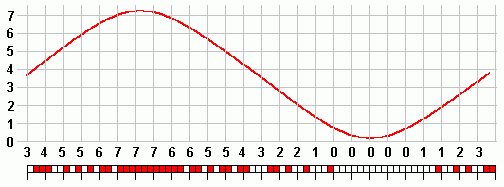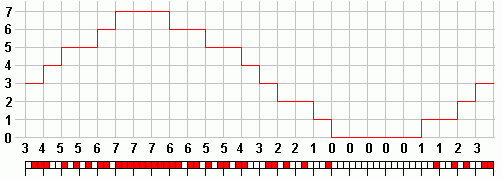 Home
Home
rOm
Quest
Glossary
Random
Page
Search
Site
Lush
Sim
Class
Subject
Images
Help
FAQ
Sign
Up
Log
In
Pulse Code Modulation
At the transmitter, the information signal is contverted into binary numbers (ADC).
At the receiver, the numbers are converted back to an analogue signal (DAC).
Encoding and Transmitting

-
To encode a transmission, the music, voice or other information signal is converted into a stream of binary numbers.
-
This is Analogue to Digital Conversion.
-
A low pass filter is needed to prevent "aliasing". This is unwanted frequencies appearing in the output.
-
The sample anf hold gate "remembers" the analogue sample voltage while the ADC performs the conversion. A changing voltage can't be converted correctly.
-
The ADC converts the sampled voltage into a N Bit binary number. 8, 10 and 16 bit converters are common.
-
The sample clock frequency is at least double the highest frequency in the information signal. (Nyquist).
-
The PISO Clock frequency is N times the Sample Clock.
-
The shift register input is an N Bit parallel binary signal. The output is a stream of N bits transmitted one after another (sequentially).
-
This stream is transmitted over a cable, wireless or fibre optic link.
-
From the transmitted signal, the original wave can be re-created (with +/- one bit error).
-
This example shows 3 bit encoding. Each sample is converted into a three bit number.

Receiving and Decoding

-
In these diagrams above, (red = 1) and (white = 0)
-
The Schmitt Trigger helps to remove noise from the received bit stream.
-
To decode PCM, the serial bit stream is converted back into parallel encoded binary numbers.
-
The N Bit Latch is needed to capture complete samples when the shift register has output a complete set of bits.
-
The ADC converts the binary numbers into an analogue signal very similar to the original signal.
-
With the three bit system shown here the reconstruction is not very good at all.
-
8 bit (approx 0.5% error) and 16 bit (minimal error) systems are much better.
-
With extra bits, the 'steps' in the staircase get smaller so the reconstruction is better.
-
The receiver SIPO Clock must be exactly synchronised with the transmitter PISO Clock.
-
Methods exist to transmit the clock signal along with the bit stream. See Wikipedia

Little and Big-Endian
Wars have started over less controversial topics.
In the PCM diagrams, 3 was converted into 011.
The war is about whether the most or least significant bit should be transmitted first using a serial link.
Endianness on Wikipedia
Subject Name
Level
Topic Name
Question Heading
First Name
Last Name Class ID
User ID
Question Text
image url
Help Link
Add
Delete
Clone
Edit
Hardness
Help Text
Debug
- You can attempt a question as many times as you like.
- If you are logged in, your first attempt, each day, is logged.
- To improve your scores, come back on future days, log in and re-do the questions that caused you problems.
- If you are logged in, your most recent wrong answers get remembered. This might help you and your teacher to correct your understanding.
- In the grade book, you can delete your answers for a topic before re-doing the questions. Avoid deleting unless you intend re-doing the questions very soon.




